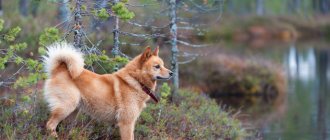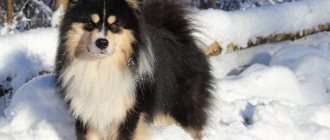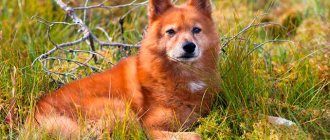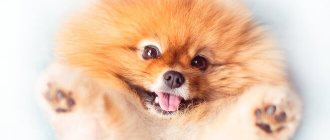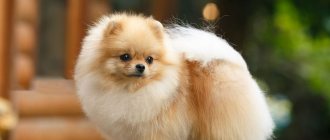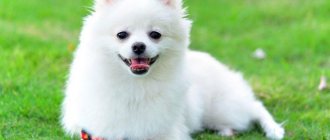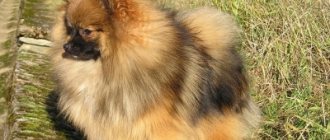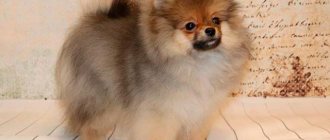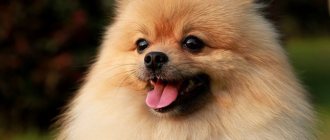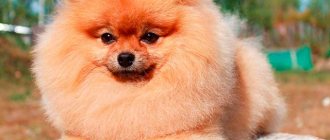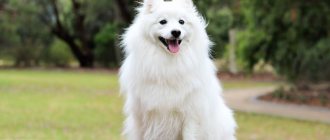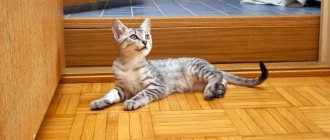Since ancient times, the inhabitants of Finland have made their living by hunting, which requires the participation of hardy, fighting, loyal dogs. For this purpose, a Finnish Spitz was used, which became not just an assistant for the owners, but also a faithful friend. Today, representatives of the breed are popular not only as hunting dogs, but also as ordinary pets.
Breed characteristics
| Short description | |
| Origin: | Finland |
| Conditions of detention: | In a house with its own yard |
| Purpose: | Hunting |
| Color: | Brown with a reddish or golden tint, possibly with a small white marking on the chest and legs |
| Wool length: | Long, except for some parts of the body |
| Adult dog sizes: | Males are 44-50 cm at the withers and weigh 12-13 kg. Females are 39-45 cm tall and weigh 7-10 kg. |
| Average life expectancy: | 13-16 years old |
| Walk: | Active, 2-3 times a day |
| Physical activity needs: | High |
| Fédération Cynologique Internationale (FIC) classification: | Group No. 5 Spitz and primitive dogs Section No. 2 Northern hunting dogs (with working exam for animals in Finland, Sweden, Norway) |
| Puppy price: | RUB 8,000-35,000 ; Pet class – 8,000-14,000 rubles; Breed class – 15,000-24,000 rubles; Show class – 25,000-35,000 rubles. |
Interesting facts about the Finnish Spitz and the price when purchasing
The Finnish Spitz is probably one of the loudest and most vocal dogs in existence.
After all, its main hunting purpose is to notify with a loud, frequent bark about the position of the game. Therefore, the ringing voice of this breed is extremely valued by expert hunters. Any exhibition championships in Finland end with a competition to determine the dog - “King of Bark”. This competition, held annually in Finland, is sometimes called the “King of the Barkers”. So, it was during one such competition on the “King of Barkers” that it was found that the unique red Spitz dog is capable of barking at a speed of 160 times per minute. Currently, the number of Finnish Spitz in Russia is quite large. This is especially true in relation to Moscow and the Moscow region, St. Petersburg and Karelia. There are nurseries in the city of Severodvinsk, Arkhangelsk region, the city of Cherepovets, Vologda region, as well as in Perm, Yekaterinburg and the region. Therefore, purchasing a purebred Finnish Spitz puppy is not a problem. The average cost of a puppy of such a dog is about 400–500 US dollars. Find out more about the Finnish Spitz here:
History of the origin of the species
The origin of dogs of this breed remains unclear; presumably their ancestors were aboriginal dogs of northern peoples (Finno-Ugric). The exact date of the appearance of the Finnish Spitz has also not been established; the first mentions are found in the descriptions of the French traveler P.M. de Lamartiniere, dated 1653 . He describes the red hunting dogs of the Scandinavian peoples, and also leaves their images in manuscripts.
At that time, Spitz dogs did not always have the same appearance, because... the different tribes rarely had contact with each other. However, the working qualities of the dogs were excellent throughout.
Dogs were used to hunt birds, which they bred under guns, small predators, such as martens, and also to drive larger animals - deer, wild boar, bear - to their owner.
In some cases, the Spitz could penetrate large burrows . One of the features of Finnish dogs was their ringing voice, with which they notified the hunter about their actions. The goal of selection was to obtain an animal with high performance characteristics, good health and not requiring special care.
After the advent of railway communication in the 19th century, residents began to actively communicate with each other. Dogs were crossed, forming mestizos with less pronounced performance indicators, which practically led to the degeneration of the breed . In 1880, the enthusiast and hunter H. Roos began rescuing Finnish Spitz and targeted selection.
In the 90s 19th century The first stud books of the breed appeared, and in 1892 a standard was developed. Dogs began participating in exhibitions 5 years later. In the 20th century dogs have gained popularity in Europe and the USA. In 1979, the Finnish Spitz was recognized as the national breed of its country. To date, these are predominantly hunting dogs with pronounced instinct.
Application
Red huskies are versatile dogs. These pets enthusiastically hunt a wide variety of game - birds, ungulates, fur-bearing animals. Some individuals of the breed successfully work for bears, beavers and other animals. When hunting, the Karelian husky makes its own decisions, driving the prey directly towards the person. This makes her an indispensable partner.
Finnish Spitz reports the discovery of game by barking. The pet raises its voice as the hunter approaches to mask the sound of his footsteps.
Modern dogs of this breed are often bred as companions. Karelian Laikas are very loyal to people, ready to accompany their owner everywhere and help him in all matters. In order for a Finnish Spitz to be happy, it must be constantly loaded with work and freedom of movement must not be limited.
Distinctive features
The FCI obliges Finnish Spitz to meet the following conformation requirements:
- The head is ovoid, gradually tapering towards the nose. The skull is wider (especially between the ears) than long. The length of this part of the head is greater than the muzzle, their ratio is 4:3. The brow ridges, stop, frontal sulcus and occipital protuberance are poorly developed. The muzzle has a dry constitution with a pronounced lower jaw.
- The bite is exclusively scissor bite. The jaws are well developed and contain a full set of teeth. The lips are thin and fit tightly.
- The eyes are almond-shaped with a lively expression, slightly slanted. Their size is normal, the shade is always dark.
- The neck is of medium length, without dewlap, with pronounced muscles. In males it looks shorter due to the wool collar.
- The ears are small, pointed, and stand upright. They have a high seating position and are in motion.
- The tail is long to the hock joint, powerful. At the very base it is thrown forward onto the back, on which it lies tightly. The tail curls down and towards the thigh, reaching half of it.
- The body is square, strong, muscular. The back is straight, short, like the loin, the croup is sloping, of moderate length. The sternum is not very wide, its length is almost 1/2 of the height at the withers. The stomach is only slightly tucked.
- The legs are straight, the bone structure is moderately expressed. The shoulder blades are flexible, longer than the obliquely located shoulders. The pasterns have a slight slope. The hips are wide, slightly larger than the shins. The metatarsals are sinewy, the paws are cat-type, with black pads that are larger on the hind legs.
- The movements move from a trot to a characteristic gallop and are distinguished by ease.
- The coat is shorter on the head and legs (except the back of the thigh). On the body, shoulder blades, pants and tail it is long. The coat is rather hard, especially on the shoulder blades of males, straight, with a pronounced soft undercoat, and thin on the ears.
The color has a smooth transition of brown from a reddish or golden hue on the back, to a lighter shade in the ears, on the sternum, cheeks, inner leg area and back of the thighs, as well as on the tail.
Description of appearance standard
The Finnish Spitz is an interesting and compact dog with a square body. The tail is cutely curled into a donut, which gives it a special playfulness.
Karelo is a Finnish beauty Laika and her description clearly gives external signs by which one can distinguish the breed.
- Weight and height for males: 45 – 50 cm, weight 12 – 15 kg;
- Females: 30 – 45 cm, weighing 10 – 12 kg;
Bitches are much smaller and lighter, and are easy to distinguish by gender. Outwardly it looks like a Spitz and a little like a fox, the similarity is especially visible on the face.
- Head: medium size, wedge-shaped, forehead – wide, stop not clearly defined. Resembles the muzzle of a fox, but wider and less pointed.
- Muzzle: medium long, pointed. Dry type, pronounced cheekbones.
- Eyes: oval, with slight slanting at the corners. The look is direct, interested. No dampness on the eyelids, full coloring. Color – brown, different saturation.
- Nose: not large, mobile, wide nostrils, color – black, fully colored. May be slightly brownish with certain coat colors.
- Jaw: strong, quite strong. The bite is scissor-shaped, the lips fit tightly, completely hiding the teeth. Color – dark. White teeth, large fangs.
- Ears: hard cartilage, ears stand up, not large, look up, triangular in shape.
- Body: square, neck rather long, medium wide. With good muscles. The back is without sag, quite wide and strong. The croup is slightly sloping, the loin is short. There are well-developed muscles throughout the body, mostly of the lean type. The stomach is tucked. There are no skin folds.
- Chest: not clearly defined, up to the level of the elbow joint, the transition is obvious.
- Paws, tail: limbs straight, stand parallel, developed muscles, hip wide, strong. The paws are collected in a dense ball, the toes are rounded with strong claws. The tail is long, curled into a ring, and thrown over the back.
Coat and colors
The Karelian Laika is the owner of a luxurious fur coat. The coat is abundant, straight, fluffy. Pleasant to the touch, quite soft, good undercoat.
- Color: red, of varying saturation, there may be spots on the chest of a light (white) color, acceptable, but not encouraged. Preference is given to rich fiery red, red and brown color.
The Laika should not have feathers, but many owners simply trim the fur in these places, this happens often. Outwardly, the brightest color - brick or even copper - red looks beautiful; it may have an admixture of dark hair, but without spots. Reminds me of the color of a fox.
Photo of an adult dog
Where is the best place to keep a husky?
Finnish Spitz have no fundamental requirements for their place of residence - they feel great both in an apartment and in a house, provided they are walked regularly.
The animal's warm, soft fur coat allows it to feel comfortable at very low temperatures and severe frost, but it is still better for the pet to live indoors rather than outdoors.
Try to allocate your pet a corner where his bedding or basket will be located so that dog toys do not disturb other residents of the house. The Spitz will feel better if the place assigned to it is away from drafts, air conditioning and heating devices.
Did you know? The first guide dogs appeared at the end of the First World War. They were invented to be trained in Germany to accompany blinded soldiers.
In addition to choosing the right place, there are several more nuances in caring for a Finnish Spitz that are worth paying attention to.
Photos of puppies
Finnish Spitz health
The Finnish Spitz, being an indigenous breed bred by nature itself, is considered a fairly healthy breed of dog. However, in practice, some problems common to the breed have been noted, such as: dysplasia of the hip elbow and knee joints, various dislocations of the limbs and epilepsy (rarely). The average lifespan of these wonderful animals is about 11–12 years.
Features of character and behavior
This is a lively and active dog with a determined demeanor. May be wary of strangers.
Advantages
- This is a socially oriented dog. She is devoted to her owner, is determined to communicate with him, and waits for approval of her actions. He treats children well, plays with pleasure, and does not show signs of aggression. She is vigilant and cautious towards strangers, but is not hostile.
- The Finnish Spitz is a very active dog with excellent working abilities . He is courageous, decisive, and capable of making independent decisions.
- A good sense of smell and stamina allow him to track or pursue prey for many hours . The dog appreciates exercise, any kind of activity, and will be happy to go on a trip to nature with its owner.
- This is a fast and quite smart dog that can successfully learn new commands . When hunting, she is passionate and emotional, but in the right situation she is able to show patience and restraint. At home, the Spitz is good-natured and friendly.
Flaws
- One of the main disadvantages of the breed is its tendency to bark and howl.
- This indicator is a plus during hunting, but in an apartment building it can cause conflict with neighbors. It is advisable to train your pet from childhood to use its voice only in the right situation. Barking at the owner should not be allowed.
- The dog requires a high load and active walking; in their absence, it is capable of destructive actions indoors. Also, when deprived of the opportunity to express energy, a Spitz can become nervous and excitable. This dog is not suitable for lying on the couch with its owner.
- Despite its attachment to its owner, the Finnish Husky can show a tendency to dominate if it feels weak. Hunting inclinations make the pet independent and decisive, so he sometimes shows stubbornness and does what he thinks is right.
- It is difficult for Spitz to get along with other animals, especially small ones. They are often perceived as being hunted. Instincts can provoke a dog to chase during a walk, so it is better to keep him on a leash.
Dream or work of the subconscious
Sigmund Freud theorized that déjà vu is the recollection of images from our forgotten dreams. This version is supported by modern dream researchers. The fact is that a person mainly dreams of scenes related to everyday life. While we sleep, the subconscious processes possible options for the development of an event that worries us at this moment in life.
And since a person rarely remembers his dreams, when something similar happens in reality, it seems that this has already happened to us. This phenomenon is based on this effect. It turns out that deja vu is the options for the development of an event calculated in a dream by the subconscious.
Care and maintenance
The Karelo-Finnish Laika does not require special care. The coat needs to be combed. The cleanliness of the ears and the absence of inflammation should be checked weekly, and if necessary, cleaned with a cotton swab. The claws wear down on their own due to active walking, but it is advisable to check their condition once a month and, if necessary, trim them. Eyes and teeth are cleaned weekly.
Nutrition
Representatives of the breed love to eat, but if there is enough exercise, they do not gain excess weight. With little activity, you should carefully monitor the diet and portion size, and do not overfeed your pet. Food can be prepared professionally or natural. In the latter case, it is worth giving additional vitamins and minerals.
The natural feeding method involves the use of the following products:
- Lean meat, offal;
- Bouillon;
- Porridge (buckwheat, rice, etc.);
- Vegetables (carrots, zucchini, potatoes);
- Unsweetened fruits;
- Eggs;
- Fermented milk products;
- Greenery;
- Fish (sea);
- Cottage cheese.
It is not recommended to give your dog bones, especially tubular ones, chocolate, spicy and smoked foods, and fatty foods.
Salt should be used in minimal quantities. Pepper and spices should not be present in the feed.
Among ready-made nutrition brands, it is worth choosing those belonging to the super-premium or holistic categories. They use natural products, lack or contain minimal amounts of dyes and flavors, and also include the required amount of vitamins.
Dogs are fed at intervals appropriate to their age. Adult Spitz dogs who are 10 months old. food is served twice a day. For puppies the following frequency is established:
- 2-4 months – 5-6 times;
- 4-6 months – 4 doses;
- 6-10 months - 3 times.
We recommend that you read a detailed article on the topic: “How and what to feed a dog: types and characteristics of nutrition.”
Health
Pets belonging to this breed are in good health. With proper care and timely vaccination, they live quite a long time.
Vaccinations
Dogs that are vaccinated develop immunity to major diseases common among dogs. Preparation for vaccination includes mandatory deworming, which is carried out a week before the event. For adult dogs, the event is held once a year .
For puppies, vaccinations must be given twice: at 8-9 weeks and at the age of 3 months . The vaccine is identical, but in the second case a rabies marker is added.
After vaccination, the puppies are quarantined for 14 days , during which the kids are not allowed to go outside. The owner needs to monitor the behavior and health of the pet during this period; if fever, vomiting, loose stools or lethargy appear, then a visit to the veterinarian is required.
Vaccinations protect against the following diseases:
- plague;
- leptospirosis;
- parainfluenza;
- coronavirus;
- hepatitis;
- parvovirus enteritis;
- trichophytosis;
- rabies.
Important article on the topic: “Everything you need to know about dog vaccinations.”
Diseases
The breed was not bred artificially, so it is distinguished by good health. Among the emerging problems are:
- Dysplasia of the hip and elbow joints . This is a congenital disease, the first manifestations of which can be noticed at the age of about 1.5 years. The dog has difficulty going down stairs and experiences pain when running or walking. If left untreated, the disease leads to immobility.
- Epilepsy. Spitz dogs may experience seizures due to a congenital brain disorder.
Walk
This is a dog that requires high exercise and active walks . She needs to run, swim, overcome obstacles. Your pet will appreciate playing ball or frisbee, hide and seek, exercise on dog equipment, and coursing.
At least once a week, the pet needs to go out into nature or freely walk in a fenced area. If there is no fence, you should not let your pet off the leash; its hunting instincts can lead it far from its owner.
Read a useful article on the topic: “Dog walking law, what you need to know about prohibitions and fines.”
Grooming
The long coat of the Finnish Spitz requires weekly brushing. During shedding, which happens twice a year , the dog's coat must be brushed daily . Bathing with shampoo is possible, but limited. 3-4 times a year is enough . In other cases, you can wipe the paws and fur with a damp cloth or rinse under running water.
Is deja vu good or bad?
Usually deja vu has a neutral meaning. However, if the phenomenon occurs to a person often, then this may be a harbinger of illness. After all, Aristotle warned that déjà vu is a malfunction of the brain that leads to serious psychological illnesses.
The words of the ancient philosopher are confirmed by experts. For example, Professor Chris Moulin talked about one of the patients at the Memory Disorders Clinic in Bath. The patient was tormented by constant obsessive déjà vu. This was due to the loss of brain cells caused by dementia.
There are many cases recorded in medicine where frequent repetitions of reality were a sign of psychological illness. It is recommended that people analyze the past less:
- with a receptive nervous system;
- patients with epilepsy;
- experiencing certain psychological problems.
Mating
Finnish Spitz are a slow maturing breed. It is undesirable to obtain offspring from representatives under 2 years of age . If the animal has reached the age of maturity, has a documented pedigree and show scores, it can be allowed for breeding.
The selected candidate for offspring must have genes that will only emphasize the advantages of both parents in the puppies. You can find a match for your pet:
- By contacting a kennel club;
- By agreeing directly with the breeder of the selected partner during the exhibition or by advertisement.
Before the meeting, it is necessary to treat the future parents for helminths, check the condition of the claws, and trim them if necessary. The dogs are introduced to the male's territory, where he can feel comfortable. For greater effectiveness, mating is repeated 2-3 times at intervals of a day.
Read a detailed article on the topic: “Everything you need to know about breeding dogs: appropriate age, what to do if it doesn’t work out, rules and tips.”
Nutrition
a balanced diet for your Swedish Spitz . The dog can be fed both high quality dry dog food and natural products. If a dog eats dry food, it is very important that it has plenty of drinking water available at all times. If the owner decides to feed the dog natural products, then the diet should include:
- Lean meats (rabbit and beef are best).
- Sea fish.
- Meat by-products.
- Dairy products.
- Porridge (buckwheat, millet and rice).
- Vegetables.
The Lapland Spitz should consume at least 250 grams of meat and offal per day; in addition, the dog needs vitamin and mineral supplements and chondroprotectors. The Lapphund should not eat smoked or pickled foods, baked goods or sweets.
Key points in training
The Finnish Spitz is a fairly smart breed that can easily master the commands of the basic set . Due to the fact that representatives of the breed mature slowly, it is better to start training a little later than other dogs. Spitz dogs can be stubborn, so training requires patience and persistence.
These dogs quickly lose interest if practicing commands is monotonous and lengthy.
It is advisable to carry out training in a playful way, diversifying it as much as possible; each exercise should be short in time, after which the dog’s attention should be switched. The Finnish Laika will not appreciate cruelty and the use of force.
Read about how to properly train a dog in the article: “Training a puppy: effective methods from dog handlers, learning commands at home.”
Memory error - the opinion of scientists
Figure 2. Scientists claim that déjà vu is a memory error
The state of “déjà vu” was first described by the French psychologist Emile Boirac in the book “Psychology of the Future.” The Frenchman was the first to define the term. After the publication of the book, a lot of other works appeared on this topic. The phenomenon was considered from both a scientific and mystical point of view. However, no accurate information has been added, since this phenomenon is spontaneous and individual. It is impossible to use technical instruments to analyze it.
In 2006, an attempt was made to analyze déjà vu using hypnosis. It was based on the fact that when a person recognizes events or people as familiar, something like this happens. The brain goes through the memories, and in case of coincidences, another area of the brain establishes the authenticity of the ongoing process. It turns out that déjà vu is the launch of the second part of information processing by mistake.
There were other theories:
- short-term and long-term memory fails, i.e. momentary information is directly sent to long-term memory;
- somehow the area of the cerebral cortex that controls familiar sensations is activated without the participation of memory;
- Déjà vu is a memory disorder.
Video
Documentary film of the TV channel “Russia 1” - “Deja Vu. Someone else's memory."
How to choose a puppy
It is better to purchase a baby Karelian-Finnish husky from a trusted breeder or nursery . This is the only way to guarantee the health of the pet and its compliance with the breed standard. When choosing a baby, you should read reviews about the nursery, the achievements of its graduates, and expected litters.
The breeder must show the pedigree of the parents, birth certificate and veterinary passport for the puppy . The baby must have a mark. It is advisable to assess the character of the future pet by watching the game with its brothers and contacting it. The dog should not be timid or frightened, but aggression is also undesirable.
The puppy's coat should be clean, not matted, and its eyes should be free of discharge . It is worth considering that the tone of the hair in babies is different from that of adult animals; it is usually gray, fawn or reddish. With age, the color becomes reddish-brown.
The Finnish Spitz is a breed for active people interested in long walks or hunting. Given the opportunity to express his energy, this dog will be a wonderful companion - good-natured, affectionate and playful.
5 / 5 ( 3 voices)
Memory of past lives
Figure 3. Jung put forward the version that déjà vu is the result of genetic memory.
The lack of accurate knowledge about the mechanisms of déjà vu has given rise to various guesses and mystical versions. Among them is the hypothesis that the phenomenon is associated with previous human lives, i.e., reincarnation. The incredible version, however, aroused the curiosity of specialists from different fields of knowledge at all times.
Remarkable! This version is completely contrary to the philosophy of Christianity. Since, according to religious canons, a person comes to earth only once. His task is to live his life in such a way that he will not be afraid to appear before God during the final Judgment.
The first version that déjà vu is a residual memory of past lives was expressed by Carl Gustav Jung. To avoid the mystical term “reincarnation,” he renamed it genetic memory.
It must be said that the Swiss theory is popular among his contemporaries. Many stars share their memories from past lives. For example, Madonna claims that in a past life she was one of the many servants of the Emperor of Manchuria. It’s interesting that she learned about this after feeling déjà vu while visiting the imperial palace in Beijing.
Another interesting story was told about herself by singer Tina Turner. Turner shared with the press that in one of her earthly incarnations she was the queen of Egypt - Hatshepsut.
Feeding your pet
Experts recommend feeding the Finnish husky with natural food. Its basis should be raw meat, which must be frozen or scalded with boiling water. Soft cartilage and offal will be beneficial for your pet (they must be boiled).
It is necessary to introduce into the dog's diet porridge cooked in meat broth, seasoned with vegetables and herbs. A little vegetable oil is also added here. Fermented milk products, eggs and sea fish without bones should be given, but not more than 2 times a week.
Natural nutrition requires additional administration of vitamin and mineral complexes. Their choice should be discussed with your veterinarian.
In rare cases, feeding ready-made food is allowed, but it is still better not to feed it to dogs that are used for hunting. When choosing ready-made food, make sure that it belongs to the super premium class and is intended for active dogs:
- Royal Canin HE Club;
- Chicopee Pro Nature Line Active;
- Acana Heritage Sport & Agility;
Acana Heritage Sport & Agility consists of 75% fresh meat ingredients
- Belcando Adult Active.
